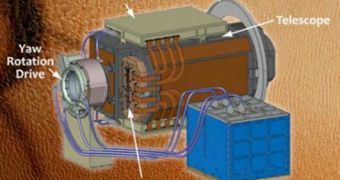As the age of space exploration progressed, space agencies and governments around the world understood that there is little countries can do on their own. The highlight of this understanding is the agreement signed by NASA and the European Space Agency (ESA) with regards to exploring Mars. The imitative calls for the first launch to take place in 2016, and the ExoMars Trace Gas orbiter is the main payload. NASA and ESA recently selected the instruments that will go on the machine, and the HiSCI is one of them.
The TGO will carry a suite of five scientific instruments, of which one is designed and built at the University of Arizona (UA). The goal of the orbiter itself is to collect accurate readings of gases that exist in the atmosphere of Mars. This knowledge may help investigators determine whether there are any biological sources of gases such as methane on the Red Planet that may hint at the present or past existence of life there. The High Resolution Stereo Color Imager (HiSCI) will not be involved in such studies directly. Rather, it will help explorers keep a close eye on the planet's surface.
“The HiSCI camera will provide us with the very best color and stereo imaging of Mars we have ever seen, so we can find and study surface changes,” explains UA professor of planetary science Alfred McEwen. He is also the leader of the HiSCI project at the university. The Lunar and Planetary Lab (LPL) facility will be in charge of managing the instrument and the science the stereo camera produces. The LPL team is made up of the same experts that are currently working on obtaining highly-detailed images of the Martian surface with the High Resolution Imaging Science Experiment (HiRISE) camera aboard the NASA Mars Reconnaissance Orbiter (MRO).
One of the main aspects that will make the HiSCI superior to the HiRISE is the fact that the former will be able to cover swaths of land that are much wider than those that can be captured with the latter. HiSCI can “see” areas that are more than 5 miles wide, whereas HiRISE is limited to less than a mile. Given the new possibilities, the LPL team will be able to discover changes that took place on the surface of the Red Planet a lot faster. Additionally, the group will also use the new data to improve on older HiRISE images, thus obtaining a double benefit from the new stereo camera.
“Over the last four years, HiRISE has photographed only 1 percent of the Martian surface, but it already has discovered many unexpected features and phenomena. It's exciting to think of all the great new discoveries we'll make with HiSCI's greater color and stereo capabilities,” Byrne adds. He explains that the UA camera and other four TGO instruments were selected from a batch of 19 proposals that were submitted to NASA and ESA this January.
“To fully explore Mars, we want to marshal all the talents we can on Earth. Now NASA and ESA are combining forces for the joint ExoMars Trace Gas Orbiter mission. Mapping methane allows us to investigate further that most important of questions: Is Mars a living planet, and if not, can or will it become so in the future?” says the ESA director for science and robotic exploration, David Southwood, quoted by ScienceDaily.

 14 DAY TRIAL //
14 DAY TRIAL //